Metacarcinus gracilis (Dana, 1852) Schweitzer and Feldmann, 2000Common name(s): Graceful rock crab, Graceful crab, Slender crab |
|
| Synonyms: Cancer gracilis | 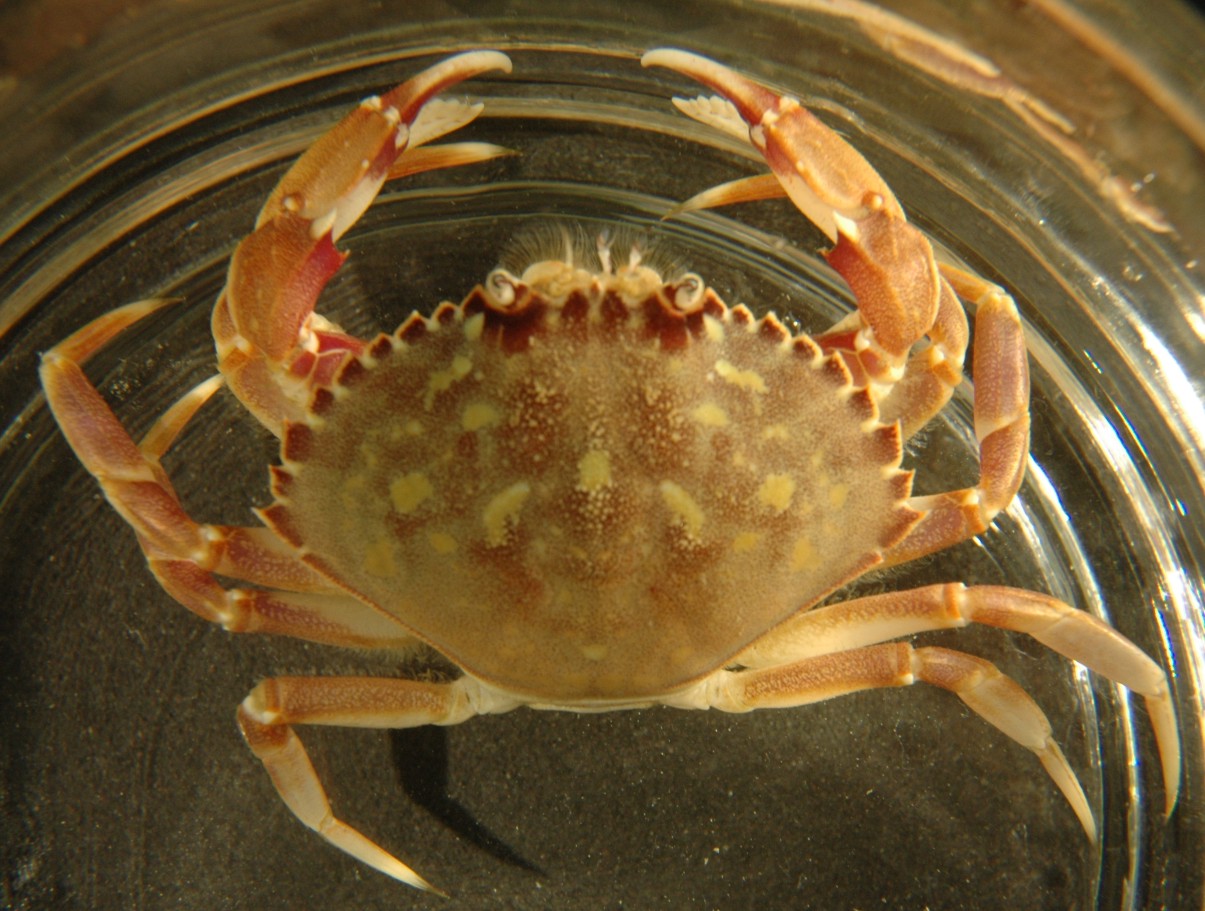 |
| Phylum Arthropoda
Subphylum Crustacea Class Malacostraca Subclass Eumalacostraca Superorder Eucarida Order Decapoda Suborder Pleocyemata Infraorder Brachyura Superfamily Cancroidea Family Cancridae |
|
| Metacarcinus gracilis, about 5 cm carapace width, from 100 m depth, San Juan Channel | |
| (Photo by: Dave Cowles, July 2006) | |
How to Distinguish
from
Similar Species:Metacarcinus
magister has a carapace
widest at the 10th tooth, with no teeth behind that point, and also has
spiny ridges on the carpus, propodus,
and dactyl
of the chela.
It also has more flattened dactyls
on the pereopods
and the dorsal surface of the upper parts of the legs is not purple.
Note: Species formerly in genus Cancer have been
recently
subdivided into several genera (Ng
et al., 2008; Schweitzer
and Feldmann, 2010). Of our local genera, Cancer and Metacarcinus have a
carapace wider than long plus only scattered setae on the carapace
margins and legs while Glebocarcinus
has a carapace of approximately equal length and width, often with
granular regions and with setae along the edges; and setae on the outer
surface of the chela as well as on the legs. Metacarcinus can be
distinguished from Cancer
because Metacarcinus
has anterolateral carapace teeth which are distinct and sharp plus the
male has a rounded tip to the telson, while Cancer
has anterolateral carapace teeth which are low and lobed, separated by
deep fissures plus the male has a sharply pointed telson (Schram
and Ng, 2012).
Geographical Range: Prince William Sound, Alaska to Baja California, Mexico
Depth Range: Intertidal to 174 m
Habitat: Mainly subtidal on sand and mud, sometimes near eelgrass beds. May be on pilings.
Biology/Natural History: This species is a scavenger, or eats small invertebrates. Predators include staghorn sculpin, starry flounder, the seastar Astropecten verrelli, and the giant octopus Enteroctopus dofleini. Females usually are found buried in the mud. Seasonally found in bays but cannot osmoregulate and does not tolerate brackish conditions. In Puget Sound eggs were borne from December to April. Males protect females after mating. Megalopae and juveniles often cling to large jellyfish such as Pelagia colorata.
| Return to: | |||
| Main Page | Alphabetic Index | Systematic Index | Glossary |
References:
Dichotomous Keys:Coffin, 1952
Flora and Fairbanks, 1966
Hart, 1982
Kozloff 1987, 1996
Smith and Carlton, 1975
Wicksten, 2009
General References:
Gotshall,
1994
Harbo,
1999
Jensen,
1995
Johnson
and Snook, 1955
Kozloff,
1993
Morris
et al., 1980
Niesen,
1997
O'Clair
and O'Clair, 1998
Scientific
Articles:
Burnett, Nicole, 2024: A practical identification guide to the zoeae of the invasive European green crab, Carcinus maenas (Linnaeus, 1758) (Decapoda: Brachyura: Carcinidae), and to the zoeae of the families of brachyuran crabs in Washington state, USA. Journal of Crustacean Biology 44:4. doi.org/10.1093/jcbiol/ruae064
Ng, P.K.L., D. Guinot, and P.J.F. Davie, 2008. Systema Brachyurorum: part I. An annotated checklist of extant brachyuran crabs of the world. Raffles Bulletin of Zoology, Supplement 17 pp. 1-286
Schweitzer, C.F. and R.M. Feldmann, 2000. Re-evaluation of the Cancridae Latereille, 1802 (Decapoda: Brachyura) including three new genera and three new species. Contributions to Zoology 69:4 pp. 223-250
Web sites:
General Notes and Observations: Locations, abundances, unusual behaviors:
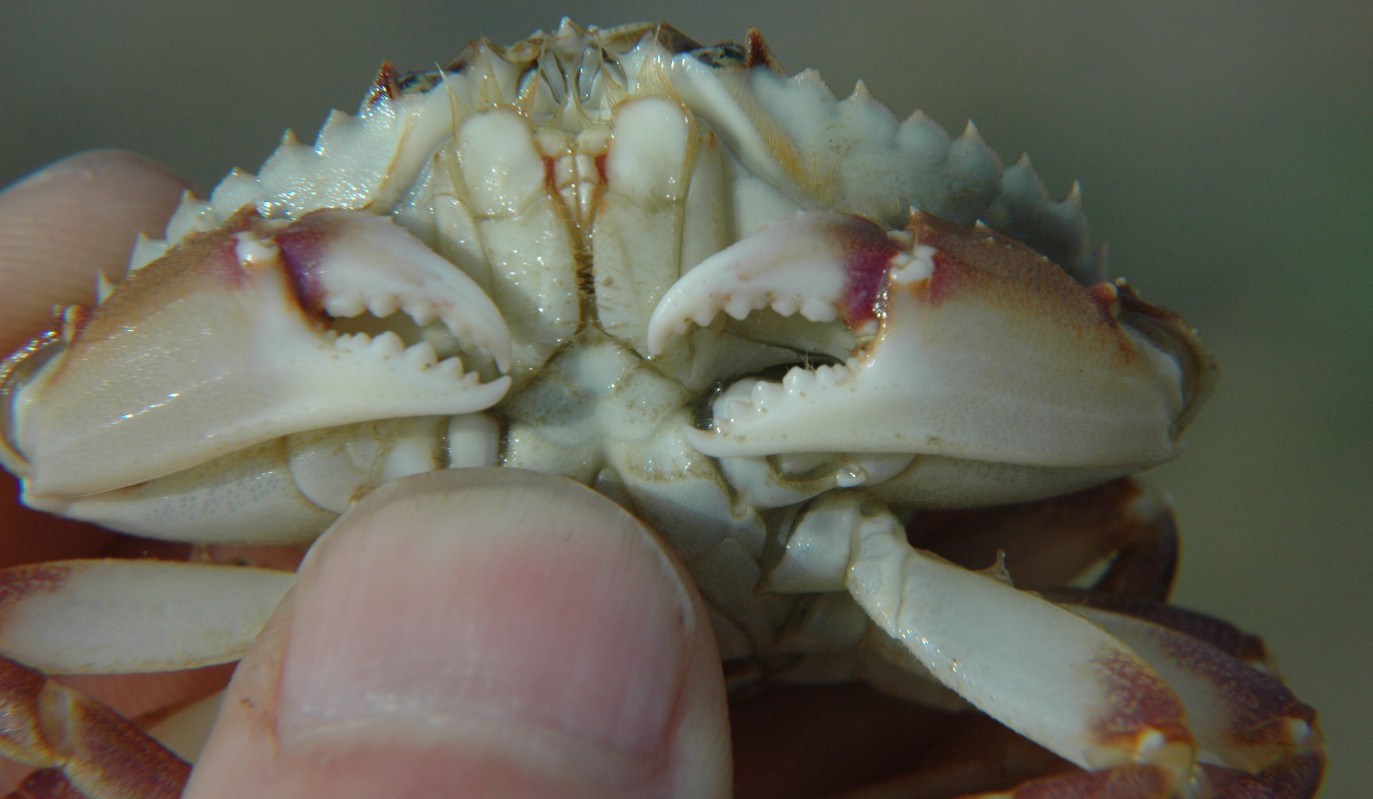
The tips of the chelae
are white. There are no spiny ridges on the carpus,
propodus,
or dactyl
of the chelae,
though there are two spines or tubercles
on the dorsal ridge of the dactyl.
The appendages seen covering the mouth are the maxillipeds,
which are found in all crabs. The white objects between the maxillipeds
are the hardened tips of the mandibles.
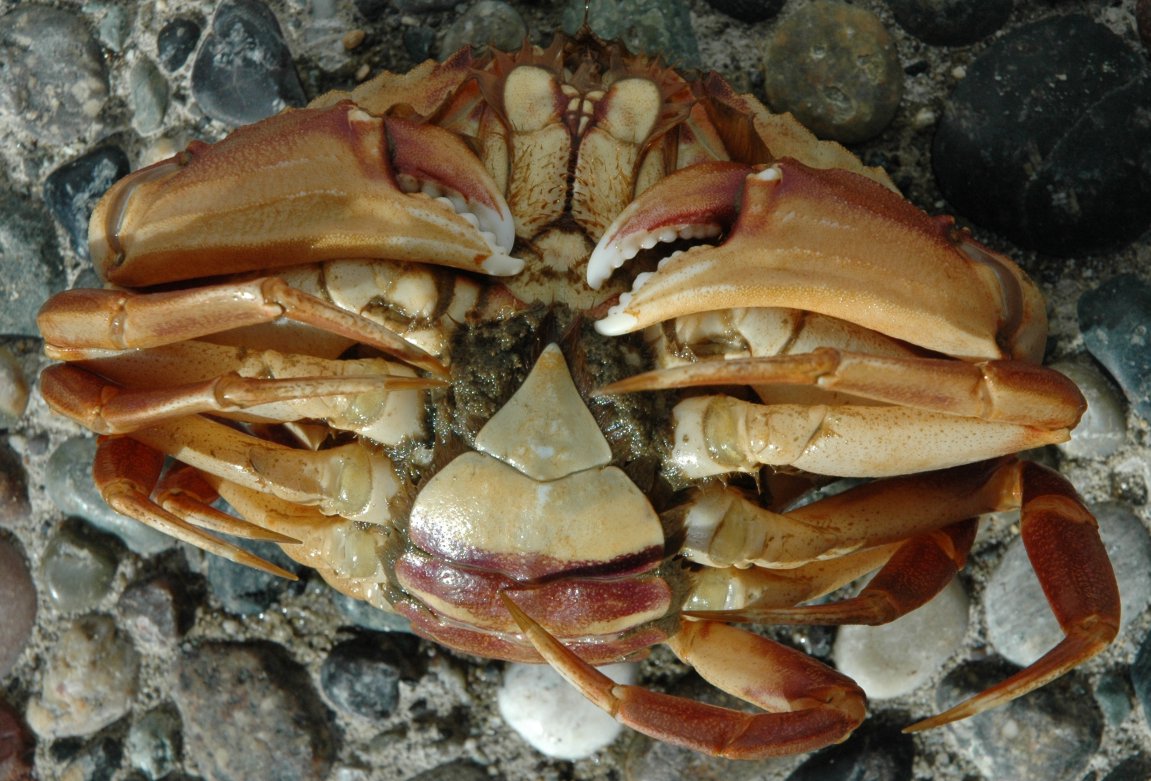 |
 |
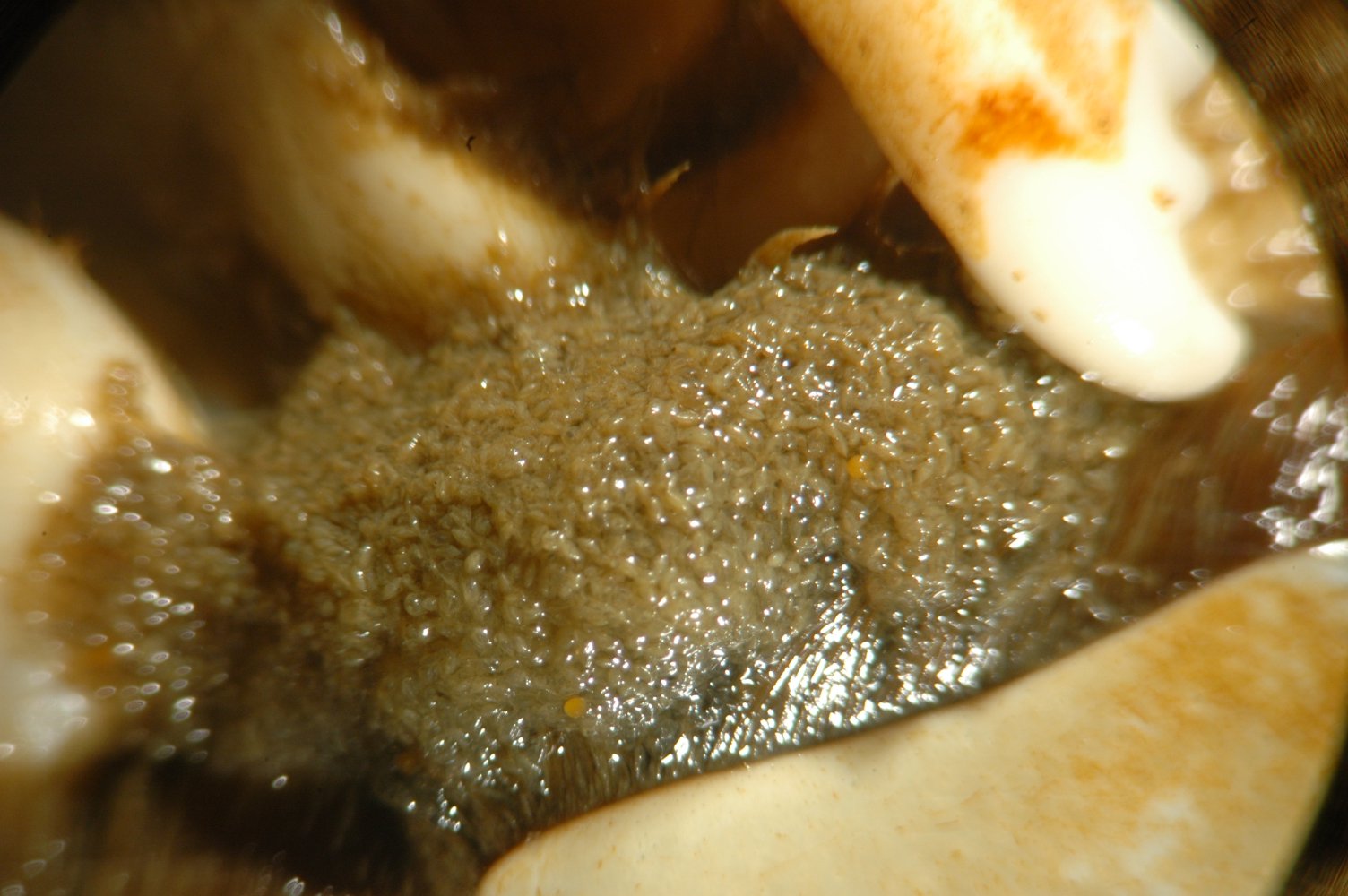 |
| This female C. gracilis, 8.5 cm carapace width, was found at March Point. She appears to be gravid (carrying eggs). The eggs, however, are much smaller and dirtier-looking than crab eggs usually are, leading me to suspect that she may be parasitized by a rhizocephalan sacculinid barnacle. However, the "eggs" did not form a sac-like structure as usually seen in rhizocephalans. | Raising the abdomen shows the dark gray and black mass of eggs. The female was docile and made little attempt to escape or to pinch. | A view through the microscope shows the mass is composed of a large number of tiny, slightly flattened, egg-like objects attached to her pleopods. Note the tip of her chela at the top right for size. I will have to watch for more gravid females to see whether these tiny, dirty-looking eggs are the norm for Cancer gracilis. Photos by Dave Cowles July 2007 |
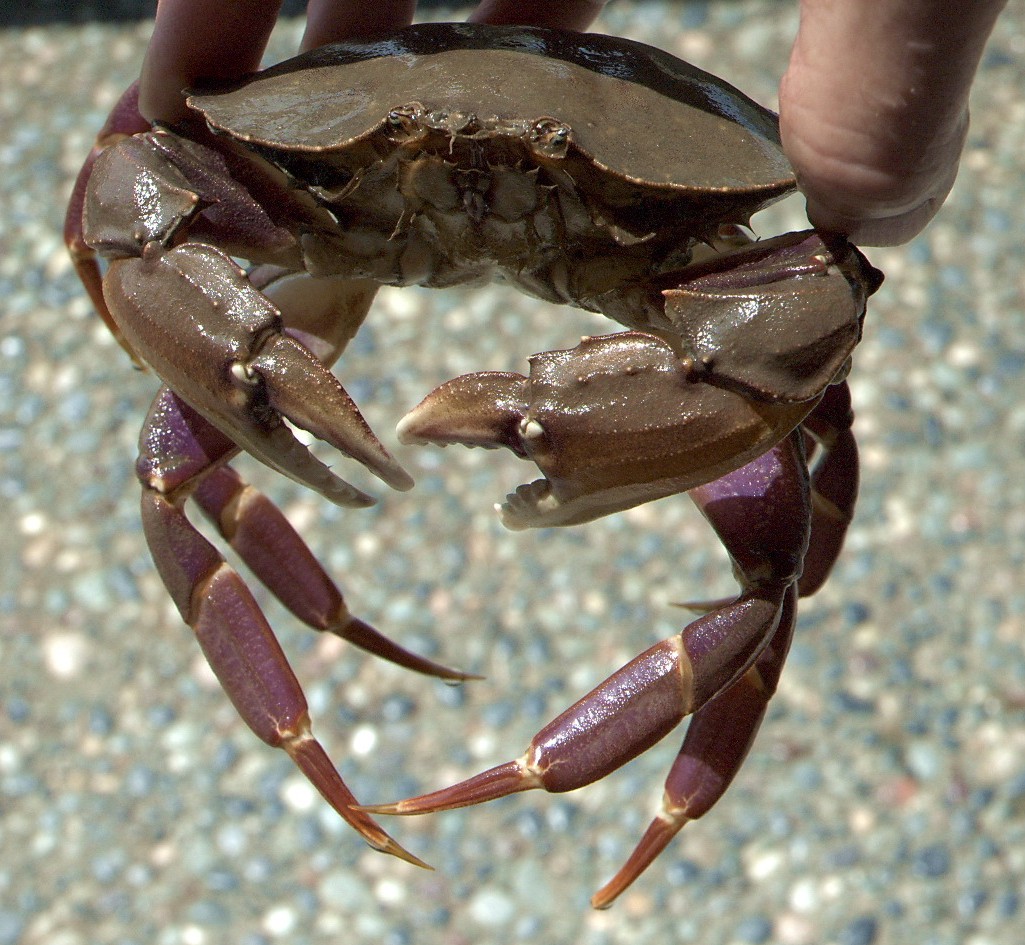
This view of a Padilla Bay crab shows the purple legs seen in many
individuals. Photo by Dave Cowles July 2008

This squeak-clean individual I found in the Rosario Seawater System
reservoir tank before starting up the seawater system in June 2016.
To get there, the crab would have had to pass through the
intake filter (maximum clearance 1 mm) the previous summer, be pumped
up the hill to the reservoit, remain in the tank 5-10 cm of water in
the bottom of the tank while the rest of the water drained out at the
end of the summer, and then survive and grow to this size in the
perhaps 1-2 cm deep coating of silt on
the bottom of the tank in total darkness for over 9 months
until we opened the seawater system again. No doubt the crab
is so clean because it has never had to deal with algal overgrowth in
the darkness. Carapace
width is 4 cm.
Authors and Editors of Page:
Dave Cowles (2006): Created original page